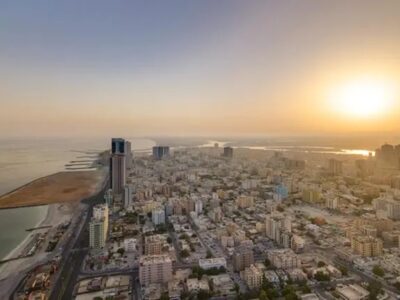Gulf economies are set to experience potentially the strongest ever growth in 2021, according to Elliot Hentov, head of strategy and policy at State Street Global Advisors.
However, he warned that the headline figures for next year will be “misleading” after what he described as “by far the worst global traction and global growth since basically we’ve had a global economy”.
Despite the gradual roll-out of Covid-19 vaccination programmes, he feared further casualties from the “wreckage” of 2020, where the coronavirus crisis wreaked havoc on global economies.
Hentov (pictured below) told Arabian Business: “It will look very misleading because the headline growth figures, the momentum and the trends, will be very strong in 2021. Not only do we see it well above the historical average of the last few years, we see it as probably one of the strongest growth years ever.
“But then we’ve had by far the worst global traction and global growth since basically we’ve had a global economy. After the biggest contraction you would expect that. But the scars of the global economy will become clear and certain parts will have become permanently disfigured.

“The momentum may be with us, but at the same time the real mess will become evident as to where the damage is and where the damage is not going to heal quickly.”
In a report last month, the International Monetary Fund (IMF) forecast that the Middle East is headed for an economic downturn this year that will be much worse than the 2008-09 global financial crisis, hammered by the coronavirus pandemic and record low oil prices.
The IMF downgraded its outlook for Middle East and Central Asian economic recovery, predicting a 4.1 percent contraction for the region as a whole – 1.3 percentage points worse than its previous assessment in April.
Hentov said: “We’ve not seen the damage to balance sheets because we’ve had such big policy support everywhere. A lot of it has been like a plaster on the wound or like morphine for the patient. We have not seen where the damaged balance sheets are; we have not seen it in credit markets. Even labour markets; unemployment is elevated and we don’t know how much further down it will go. Is this the end of the recovery or will we get still a rapid reintegration of the newly unemployed.”
According to the Economic Update: Middle East Q4 2020 report from Oxford Economics and commissioned by chartered accountancy body ICAEW, economic recovery is slowly underway in the Middle East but won’t return to pre-crisis level until 2022.

Michael Armstrong (pictured above), FCA and ICAEW regional director for the Middle East, Africa and South Asia (MEASA), said: “2020 has been a challenging year for Middle Eastern economies. The dual shock of the Covid-19 pandemic, paired with continued uncertainty in the global oil market, has meant that, in 2020, the Middle East economy is experiencing its lowest growth in decades.”
A vaccination programme started in Abu Dhabi on Monday, while various Covid-19 vaccines have been approved by authorities in Bahrain, Kuwait and Saudi Arabia.
However, Armstrong cautioned: “While the Covid-19 vaccine rollout is underway, the Middle East governments must ramp up their economic diversification efforts by developing sectors and industries that generate net value for the economy and fostering innovation.”
Fitch Ratings has previously warned that the economic recovery in the MENA region will be dampened by a weak oil demand outlook and fiscal consolidation efforts after a sharp rise in debt in 2020.
Five of the 15 Fitch-rated MENA sovereigns are on a negative outlook, after revisions on Saudi Arabia, Oman, Iraq, Jordan and Tunisia in 2020. Fitch Ratings has also downgraded Bahrain, Lebanon, Morocco, Oman and Tunisia during the year while Lebanon has been in default since March.
Hentov said he believed oil prices would “stabilise” by the middle of next year to around $50-a-barrel.
He said: “I see demand recovering, not to its full extent, but given that I also see supply constraints balancing that out, that too gives me confidence that a big step down is unlikely.”
In its latest Economic Update, ICAEW’s estimate for Brent crude is US$41.7pb for this year and US$49.3pb in 2021, slightly higher than forecasted figures back in March. However, it said there is limited upside for oil prices through 2022 and 2023.
“The subdued outlook for oil prices will limit GCC governments’ room to provide fiscal support, preventing growth from returning to the levels they were at the end of 2019 before late 2022, later than most other regions in the world,” it said.








